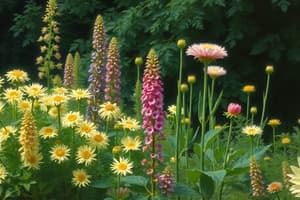Podcast
Questions and Answers
Which type of plant lacks vascular tissue and includes mosses, liverworts, and hornworts?
Which type of plant lacks vascular tissue and includes mosses, liverworts, and hornworts?
- Gymnosperms
- Seed plants
- Nonvascular plants (correct)
- Seedless vascular plants
What type of generation is dominant in the life cycle of ferns?
What type of generation is dominant in the life cycle of ferns?
- Sporophyte generation (correct)
- Gametophyte generation
- Mature generation
- Seedling generation
In the life cycle of moss, what is the required condition for fertilization?
In the life cycle of moss, what is the required condition for fertilization?
- Presence of seeds
- Incorporation of light
- Dry conditions
- Availability of water (correct)
What are the primary structures formed by apical meristems in vascular plants?
What are the primary structures formed by apical meristems in vascular plants?
Which of the following is a characteristic of seed plants?
Which of the following is a characteristic of seed plants?
What adaptation allows vascular plants to thrive in a wider range of environments compared to nonvascular plants?
What adaptation allows vascular plants to thrive in a wider range of environments compared to nonvascular plants?
Which group of seed plants includes flowering plants?
Which group of seed plants includes flowering plants?
Which statement is true about seedless vascular plants?
Which statement is true about seedless vascular plants?
What role do roots play in land plants?
What role do roots play in land plants?
Which adaptation helps plants grow taller and capture more sunlight?
Which adaptation helps plants grow taller and capture more sunlight?
What is the function of vascular tissues in land plants?
What is the function of vascular tissues in land plants?
What adaptation prevents desiccation in land plants?
What adaptation prevents desiccation in land plants?
How do stomata benefit land plants?
How do stomata benefit land plants?
What evolutionary advantage did the development of apical meristems provide to plants?
What evolutionary advantage did the development of apical meristems provide to plants?
Which of the following is a consequence of coevolution between plants and animals?
Which of the following is a consequence of coevolution between plants and animals?
What was an early adaptation of plants to combat desiccation?
What was an early adaptation of plants to combat desiccation?
Which system in vascular plants is primarily responsible for the transport of water and minerals?
Which system in vascular plants is primarily responsible for the transport of water and minerals?
What distinguishes ferns from other seedless vascular plants in terms of evolution?
What distinguishes ferns from other seedless vascular plants in terms of evolution?
What role do roots play in vascular plants compared to non-vascular plants?
What role do roots play in vascular plants compared to non-vascular plants?
Which plant group is characterized by having only a single living genus?
Which plant group is characterized by having only a single living genus?
In the life cycle of moss, which structure signifies the sporophyte generation?
In the life cycle of moss, which structure signifies the sporophyte generation?
Which adaptation allows vascular plants to effectively capture sunlight for photosynthesis?
Which adaptation allows vascular plants to effectively capture sunlight for photosynthesis?
What is a defining characteristic of apical meristems in vascular plants?
What is a defining characteristic of apical meristems in vascular plants?
During which geological period did large trees and swamp forests of seedless vascular plants, including ferns, predominantly grow?
During which geological period did large trees and swamp forests of seedless vascular plants, including ferns, predominantly grow?
Flashcards
Vascular plants
Vascular plants
Land plants with specialized tissues (xylem and phloem) for transporting water, nutrients, and sugars.
Xylem
Xylem
Vascular tissue that transports water and minerals in plants.
Phloem
Phloem
Vascular tissue that transports sugars, proteins, and other solutes in plants.
Roots in vascular plants
Roots in vascular plants
Signup and view all the flashcards
Mycorrhizae
Mycorrhizae
Signup and view all the flashcards
Seedless vascular plants
Seedless vascular plants
Signup and view all the flashcards
Sporophyte (2n)
Sporophyte (2n)
Signup and view all the flashcards
Ferns (seedless vascular plants)
Ferns (seedless vascular plants)
Signup and view all the flashcards
Plant adaptations for land
Plant adaptations for land
Signup and view all the flashcards
Shoot evolution
Shoot evolution
Signup and view all the flashcards
Vascular tissue (xylem & phloem)
Vascular tissue (xylem & phloem)
Signup and view all the flashcards
Root evolution
Root evolution
Signup and view all the flashcards
Cuticle
Cuticle
Signup and view all the flashcards
Stomata
Stomata
Signup and view all the flashcards
Plant defenses
Plant defenses
Signup and view all the flashcards
Plant-animal coevolution
Plant-animal coevolution
Signup and view all the flashcards
Seed plants
Seed plants
Signup and view all the flashcards
Gymnosperms
Gymnosperms
Signup and view all the flashcards
Angiosperms
Angiosperms
Signup and view all the flashcards
Dominant generation (plants)
Dominant generation (plants)
Signup and view all the flashcards
Seedless Plants
Seedless Plants
Signup and view all the flashcards
Study Notes
Diversity of Plants
- Plants play a crucial role in the planet's ecosystems.
- All plants share a common evolutionary ancestor, making them monophyletic.
- To transition from water to land, plants evolved adaptations to avoid drying out, disperse reproductive cells, gain structural support, and absorb sunlight.
- Seed plants developed specialized structures to thrive in drier environments, whereas seedless plants require more moisture.
Plant Kingdom
- Most plants use chlorophyll in chloroplasts for photosynthesis.
- Plant cell walls are composed of cellulose.
- Plants reproduce both sexually and asexually.
- Plants exhibit indeterminate growth, meaning they continue growing throughout their lifespan.
Plant Adaptations to Life on Land
- Desiccation (drying out) is a significant threat to terrestrial organisms, requiring adaptations by plants. Water supports aquatic life but not terrestrial plants.
- In water, sperm swim to the egg; on land, specialized methods are necessary. The egg and zygote must also be protected from drying out.
- Sunlight and carbon dioxide are more abundant in the air and can aid photosynthesis in terrestrial plants.
- Early land plants were close to water sources and had drought tolerance as their primary adaptation. This ability can be seen in mosses, able to return to their green form when rehydrated.
- Other plants thrive in humid environments to avoid drought conditions.
Alternation of Generations
- Alternation of generations describes a life cycle with both haploid and diploid multicellular stages in some organisms (plants).
- Haploid (n) multicellular stage is called a gametophyte. Gametophytes produce gametes (n) through mitosis.
- Fertilization produces a diploid zygote (2n), which develops into a diploid multicellular sporophyte. Sporophytes create spores (n) through meiosis.
- Spores give rise to new gametophytes, restarting the cycle.
Seed Plants vs. Seedless Plants
- In seed plants, the sporophyte (2n) generation is the most noticeable, as evidenced by ferns and trees.
- In seedless plants (mosses and relatives), the gametophyte (n) generation is the most dominant form, easily visible as a green carpet.
- Embryo protection is critical for land plants, necessitating environments shielded from drying and other risks.
- Seedless plants require water for fertilization.
Apical Meristems
- Plants grow in length due to apical meristems at shoot and root tips, acting as stem cells.
- These cells continuously divide throughout the plant's life, enabling upward growth toward light and downward growth in the soil for water and mineral absorption.
Additional Land Plant Adaptations
- New organs and structures evolved in response to dry land, promoting greater height in plants (via structural support).
- Vascular systems transport water, nutrients, and minerals throughout the body. The development of vascular tissue allowed for larger plants.
- Roots evolved for absorbing water and minerals, stabilizing plant growth and anchoring them in the soil.
- A protective, waxy cuticle coats leaves and stems, slowing water loss. Stomata allow gas exchange while minimizing water loss.
Major Divisions of Land Plants
- Land plants are categorized by the presence or absence of vascular tissue.
- Nonvascular plants (bryophytes) include mosses, liverworts, and hornworts, and were early forms of land plants.
- Vascular plants have a network of conducting tissues called xylem and phloem, classified into seedless and seed plants.
Seedless Plants
- A small portion of the plant kingdom, seedless plants commonly thrive in damp, shaded environments. They were prevalent during the Carboniferous period.
Gymnosperms
- Gymnosperms are cone-bearing plants; their wood is more primitive than angiosperm wood. Characteristics include naked seeds, separate male and female gametes, wind pollination. Conifers are the dominant phylum.
- Conifers, an example, have needle or scale-like leaves, and thrive in high altitudes, prevalent in colder climates.
- Cycads, with palm-like leaves, thrive in mild climates, dominated the landscape during the age of dinosaurs.
Life Cycle of Conifers
- Male cones produce pollen, while female cones house ovules, providing a way for fertilization by wind.
- Fertilization, often taking years, produces seeds.
Diversity of Ginkgos and Gnetophytes
- Ginkgophytes comprise a single surviving species (Ginkgo biloba), often planted in urban areas because it's resistant to pollution.
- Gnetophytes comprise ancient species, closely related to angiosperms. Several species exist.
- Ephedra, a species in this group, contains ephedrine, a stimulant used in medications, but restricted for its similarity to amphetamines.
Seed Plants: Angiosperms
- Angiosperms, flowering plants, dominate most ecosystems and exhibit great diversity.
- Two key adaptations are flowers and fruits, improving pollination and seed dispersal.
- Flowers create relationships with pollinators for targeted seed spread. Fruits enclose the developing seed for protection and seed dispersal.
Diversity of Flowering Plants
- Modern angiosperms originated from a single ancestor; the group has been divided into two major sections, monocots, and eudicots, based on features like the presence of a single cotyledon (seed leaf).
- Monocots comprise grasses and other important food sources, characterized by features such as a single cotyledon, parallel leaf venation, and flower parts in multiples of three.
- Eudicots, a larger group, include more than two-thirds of flowering plants, and the presence of two cotyledons, often netlike leaf venation, and flower parts in multiples of four or five characterize this group
- Basal angiosperms are a group of early-branching species that possess traits common to both monocots and eudicots,
Flowers
- Flowers are modified leaves arranged around a central stalk, containing vital reproductive parts (sepals, petals, carpels, stamens), and supporting seed development in the ovary.
Fruit
- Fruit develops from the ovary once fertilization occurs and seeds form.
- Fruits aid in seed dispersal, employing various methods like wind, water, and animal consumption.
Life Cycle of Angiosperms
- Like gymnosperms, the angiosperm sporophyte is dominant.
- Spores develop into male and female gametophytes within the flower.
- Pollen grains carry sperm, and fertilization results in a zygote. The resulting tissue is the endosperm, providing nutrients for the developing embryo.
- The diploid zygote develops into a new sporophyte (plant). Seeds contain the embryo and endosperm enclosed in a seed coat.
- Plants may be monoecious, having perfect flowers with both male and female parts in the same flower, or dioecious, with separate male and female flowers on different plants.
Studying That Suits You
Use AI to generate personalized quizzes and flashcards to suit your learning preferences.




